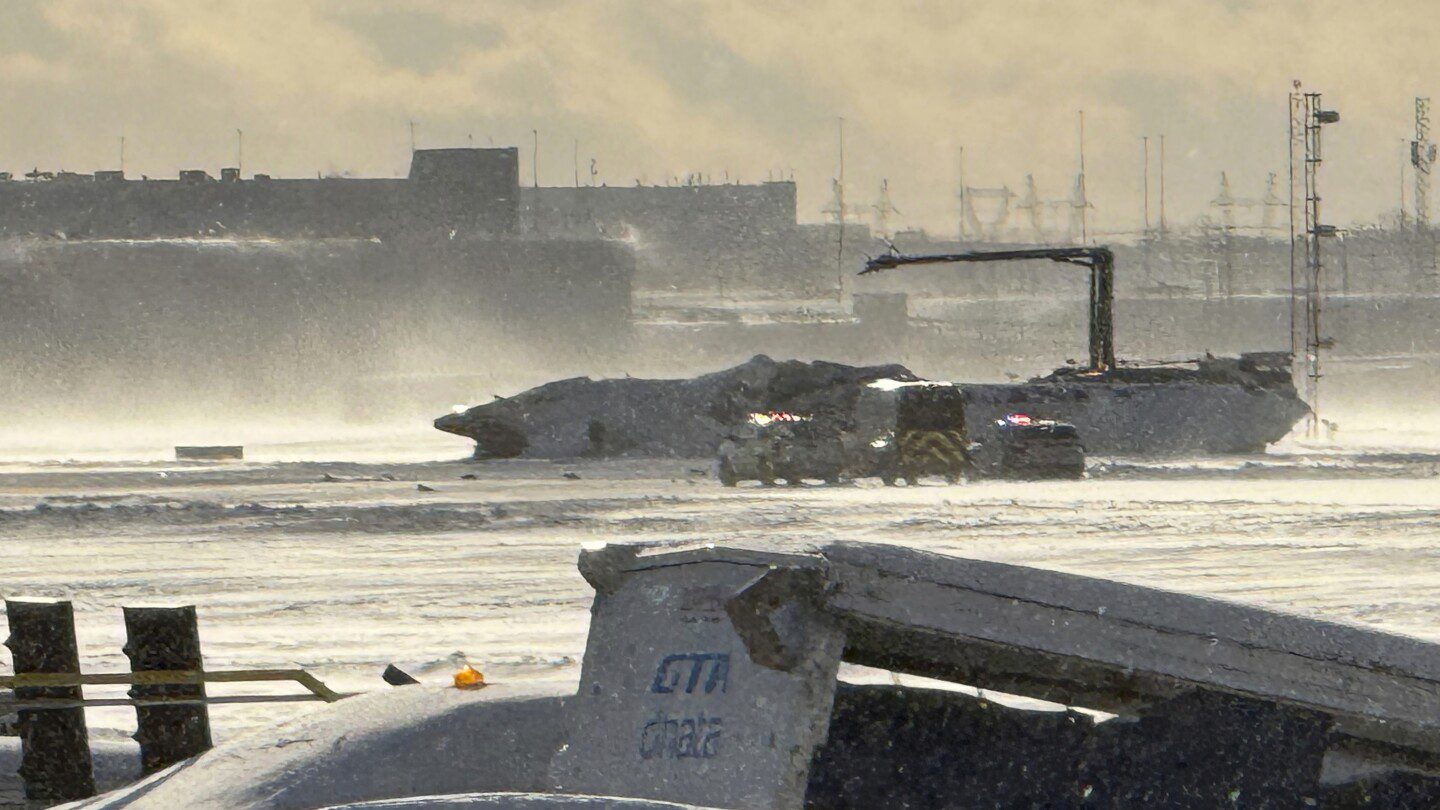
Delta Airlines Plane Overturns at Toronto Pearson Airport, All Passengers Survive
Toronto (AP) – A Delta Air Lines aircraft landed upside down at Toronto’s Pearson Airport on Monday, with all 80 individuals onboard escaping with only minor injuries, according to the airport’s CEO.
Snow whipped up by wind gusts reaching 40 mph (65 kph) caused blizzard-like conditions as the flight from Minneapolis, carrying 76 passengers and four crew members, attempted to touch down around 2:15 p.m. Though communication between the control tower and the pilot remained normal during approach, the exact cause of the incident after touchdown remains unclear.
Passenger Peter Carlson, who was en route to Toronto for a paramedics conference, described the landing as “very forceful.” He recounted, “Suddenly, everything went sideways, and in the blink of an eye, I was upside down, still strapped in,” in an interview with CBC News.
Canadian officials organized two brief press conferences but provided minimal details regarding the incident. Social media footage captured the aftermath, showcasing the Mitsubishi CRJ-900LR flipped over, with its fuselage intact and firefighters extinguishing the remnants of the fire while passengers exited the aircraft and navigated the tarmac.
“We are incredibly thankful that there were no fatalities and that injuries were minor,” expressed Deborah Flint, CEO of the Greater Toronto Airports Authority.
Delta’s CEO Ed Bastian offered condolences, stating, “The hearts of the entire Delta family are with everyone affected by this incident.”
According to Toronto Pearson Fire Chief Todd Aitken, 18 passengers were transported to local hospitals. Earlier in the day, Ornge air ambulance confirmed the airlifting of one pediatric patient to SickKids hospital in Toronto along with two injured adults to various hospitals in the area.
Emergency responders reached the aircraft quickly, and Aitken stated that the response proceeded as intended. He noted that weather conditions included dry runways with no crosswinds.
This incident marks the fourth significant aviation accident in North America within three weeks. In a separate incident on January 29, a commercial airliner collided with an Army helicopter near Washington, D.C., resulting in 67 casualties. Additionally, a medical transportation aircraft crashed in Philadelphia on January 31, claiming six lives aboard as well as one on the ground. Notably, another incident occurred in Alaska on February 6, leading to the death of 10 individuals.
The last major aviation incident at Pearson took place on August 2, 2005, when an Airbus A340 from Paris skidded off the runway amidst stormy weather. Fortunately, all 309 passengers and crew aboard Air France Flight 358 survived.
On the day of the crash, Pearson Airport was affected by blowing snow and winds averaging 32 mph (51 kph) with gusts reaching 40 mph (65 kph). The temperature registered at approximately 16.5 degrees Fahrenheit (minus 8.6 degrees Celsius). The Delta flight received clearance to land around 2:10 p.m., with audio recordings indicating that the tower cautioned the pilots about potential airflow disturbances during their approach.
John Cox, CEO of Safety Operating Systems, an aviation safety consultancy, remarked, "It appears the controller aimed to assist by warning the pilots of possible turbulence during the descent." He added, "While the windy conditions are notable, aircraft are designed to withstand such challenges, and pilots receive thorough training to manage these situations."
The aircraft came to rest at the intersection of Runways 23 and 15L, near the runway’s beginning. Communication between the tower and a departing medical helicopter indicated that passengers were seen exiting the plane. The medical helicopter pilot confirmed the plane was upside down and on fire.
Among those who managed to exit was Carlson, who, upon unfastening his seatbelt, found himself on the ceiling—now the floor—of the aircraft. He detected gasoline fumes, observed aviation fuel running down the windows, and instinctively sought to assist others. Carlson, alongside another passenger, helped a mother and her young son escape before making his way onto the tarmac amid the snow.
“It felt like stepping onto tundra,” Carlson reported. “I didn’t care about the cold or the distance; all I wanted was to escape the aircraft.”
Cox, a seasoned aviator with 25 years at U.S. Air, provided insight into the CRJ-900’s reliability in adverse weather scenarios. While it’s uncommon for an aircraft to end up inverted, he explained, “There have been rare instances where planes have taken off and ended up turned over; however, it’s quite unusual.”
Significant questions arise concerning the absence of the plane’s right wing, which could have contributed to its roll-over. Cox emphasized the importance of locating the flight data and cockpit voice recorders to understand the details of the incident thoroughly.
The U.S. Federal Aviation Administration stated that the Transportation Safety Board of Canada will lead the investigation and provide updates. The National Transportation Safety Board (NTSB) in the U.S. will send a team to assist with the inquiry.
Endeavor Air, which operates as a subsidiary of Delta Air Lines, holds the distinction of being the largest global operator of CRJ-900 aircraft, conducting 130 regional jets on 700 daily flights across over 126 locations in the U.S., Canada, and the Caribbean.
The CRJ-900 aircraft, developed by Canadian aerospace manufacturer Bombardier, belongs to the same family as the CRJ-700 involved in the midair collision near Reagan National Airport on January 29.
___
Casey reported from Concord, New Hampshire, with additional contributions from Associated Press journalists Michael Sisak in New York, Jack Dura in Bismarck, North Dakota, Alex Veiga in Los Angeles, and Jim Morris in Vancouver, British Columbia.









